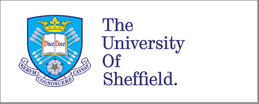The historical sources
The aim of the Lands of the Normans project is to produce a prosopographical resource for the genealogy and landholding of a sample of Anglo-Norman families before and after 1204, based on the surviving evidence from the twelfth and thirteenth centuries. As in any historical project, the nature, extent and quality of the surviving historical sources is an important factor influencing the aims and approaches adopted and determining the level of detail in which the past can be reconstructed. The current discussion is intended to place the historical sources in their proper context, in the hope that this will help users better to understand the information contained in the database. It has been illustrated with sample images from the original documents. A full list of sources cited in the database can be found in the bibliography of sources cited in the 'Lands of the Normans' dataset, although this is not an exhaustive list of all the extant primary sources.
The nature of the sources
The first point to stress is that there is a dramatic change in the amount and nature of the historical evidence during the period covered by this project. From around the turn of the thirteenth century the number and variety of surviving sources increases dramatically as part of what has been called a 'bureaucratic revolution'. In particular, the English (and, to a lesser extent, the French) kings began to keep copies of many of the charters, letters and writs issued by their clerks. This has a significant impact on the way that history can be written for the years before and after 1200. There is also an equally noteworthy difference in the surviving evidence from England and from France and this, combined with differing historical traditions and approaches, has influenced the way that history is written in the two countries.
The history of the Anglo-Norman aristocracy in the twelfth century is based largely on sources produced and preserved privately (mostly by religious houses), such as cartularies (collections of charters copied into manuscripts) and chronicles, rather than on records kept in the archives of the royal government itself. Royal charters and letters are an important source, but since the government kept few records of the orders it issued, they are only known where the original either survives in the archives of the recipient or was copied into a cartulary or chronicle. Two important exceptions in England are the Pipe Rolls, the records of the annual audit into the accounts of the sheriffs, and the two great tenurial inquests of 1086 (the Domesday Survey, which led to Domesday Book) and 1166 (the Cartae Baronum).
After 1200 there is a greater wealth of sources, especially in England. In these years there was an almost exponential growth in the survival and retention of historical material. For example, While the Acta of the Plantagenets project has identified over 3,000 acta from the thirty-five year reign of Henry II (1154-1189), it has been estimated that there are around 30,000 surviving royal acta for each year of his grandson Henry III's reign (1216-1272) (see B. U. Weiler, 'Politics', The Central Middle Ages: Europe 950-1320, ed. D. J. Power (Oxford, 2006), p.102). In England, the chancery clerks began to enrol copies of many of the writs and charters that they issued. These form the great series of the Charter, Close and Patent rolls (later joined by more series). There are some indications that these records may have been kept in some form before 1200, but they do not survive in any number. At around the same time in France, a number of registers containing selected acts of King Phillip II (Philip Augustus) also began to be compiled. Most later medieval historians work on these enrolled copies rather than on the original writs or charters that were actually issued. One paradoxical consequence of this is that much more is known about, for example, the royal chancery in the twelfth century than the thirteenth, because it is vitally important for the earlier historian to be able to distinguish genuine royal charters from forged or altered documents.
These new sources present a tremendous opportunity. They allow the historian to ask and answer new types of questions, while the increased volume of material allows the course of politics and administration or the histories of individual families or places to be reconstructed in a new level of detail. At the same time, however, the greater number and variety of historical sources poses a different set of challenges to the historian. Rather than straining to extract every last drop of information from his sources, the thirteenth-century historian has to distil relevant information from a sea of noise. The simple task of searching and analysing such vast quantities of data represents a significant logistical challenge and an important aim of the "Lands of the Normans" projectwas to investigate how these varied sources could be incorporated within a single database and produce standardised information about people and places, while recognising the individual nature of each source.
Royal records
Although the medieval state was limited by modern standards, the royal government still had a number of important duties. The essential role of the king, derived from biblical and classical exemplars, was to mantain order and ensure justice within the kingdom and to defend his realm against external threats. The public functions of government required a framework of central and local administration to raise the necessary funds and to execute royal orders. In particular, the need to fund expensive campaigns was a driving force behind the development of royal government. After 1204 John raised staggering amounts of money in his attempts to regain his lost provinces on the continent. All of this activity produced a growing number of records, especially from c.1200 as the royal bureaucracy became more self-conscious.
The Lands of the Normans project has largely concentrated on the records of the English royal administration. Medieval kingship was highly personal in nature and centred in the royal household. However, as the duties of government expanded during the twelfth century, the omnicompetent curia regis began to specialise and divide into departments. This process continued during the thirteenth century. Most of the surviving records were produced by three main departments of medieval English government: the Chancery; the Exchequer; and the various law courts. These departments and the records that they produced will be considered in that order. It should always be remembered that these departments formed part of a single system. For example, it is possible to follow a single thread, such as a legal dispute, from the original fine made by the plaintiff to have his case heard by the king's justices (recording in the Chancery fine rolls), to the collection of that fine from the plaintiff (in the Exchequer Pipe Rolls), to the hearing of the plea itself (in the plea rolls of the royal courts).
Chancery
The Chancery was the royal secretariat. It developed out of the team of household clerks who accompanied the king and manned his chapel. The head of the chapel or chancellor was one of the king's leading ministers and held the Great Seal, which was used to authenticate most royal orders. Although in the eleventh and twelfth centuries, many royal charters may actually have been written by the recipients and merely sealed with the king's Great Seal, the king's household clerks were literate and could write letters and charters when necessary. By the late twelfth century most royal letters and charters were written by the chancery clerks and, from around 1199, copies were enrolled and retained at the Chancery. The chancery also played a key role in the judicial system, since original writs to initiate litigation before the king's courts had to be acquired at the chancery. Unfortunately, copies of the majority of these routine judicial writs were not enrolled. During most of the twelfth and thirteenth centuries the chancery continued to travel with the king and the personality of the ruler can sometimes be seen in the records.
The Charter Rolls (TNA class C 53)
Royal charters were the most solemn form of royal document. They were used to make permanent grants of land and some other rights, such as liberties, privileges, immunities, exemptions and peerages. Royal charters were also used to confirm earlier grants, either by previous rulers or private individuals. Some confirmatory charters use the form Inspeximus or vidimus, in which the king inspects/views and confirms an earlier grant, which is usually repeated in full. Charters contain full formal titles and introductions, and also a list of witnesses to the act. The evidence of witness lists to royal charters can be used to reconstruct attendance at court. The earliest enrolled charter roll dates from the first year of John's reign, although it also contains other material, such as letters patent.
The first image shows an original royal charter of 1231 in favour of Hubert de Burgh. As the leading figure in the young Henry III's government, de Burgh was well-placed to build up his landed estates and the royal charter in question confirms some of his gains. These included the terre Normannorum manors of Wynford Eagle (recently confiscated from the Norman lord Gilbert de l'Aigle) and Hatfield Peverel (which had been confiscated in 1204 from another Norman, Robert fitzErneis). A royal charter was an important document intended for display and this is reflected in the appearance. The scribe has obviously taken great care over the document. The script is large and well-formed. Some royal charters have either an illuminated first initial H of Henricus or a blank space there for the recipient to add their own illumination. The charter was authenticated by the attachment of Henry III's Great Seal, and a damaged seal can be seen in this example.
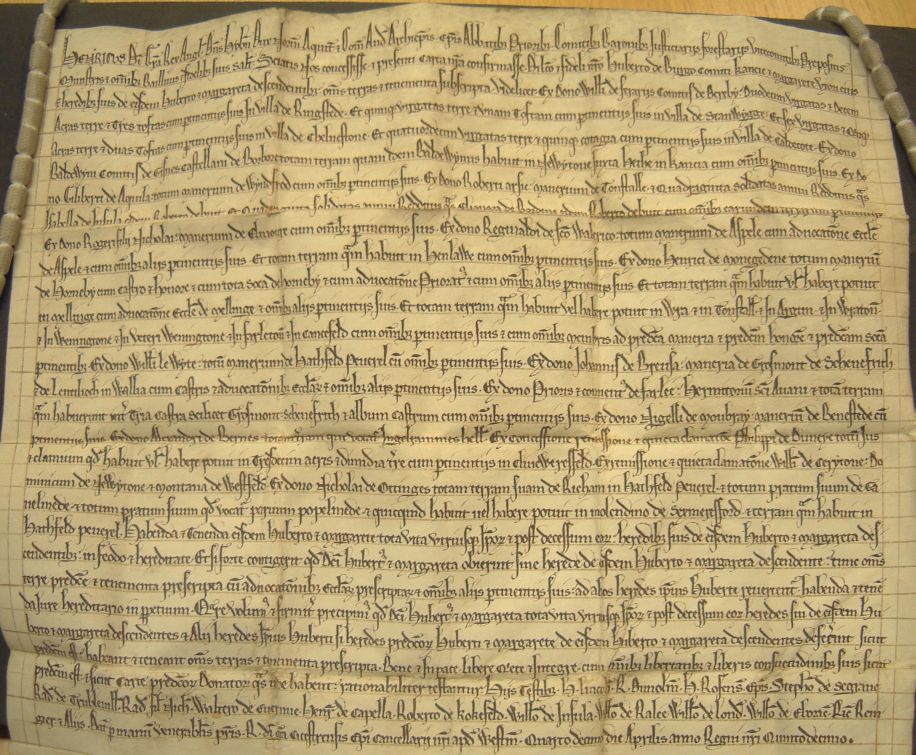
The second image shows the enrolled copies of three other royal grants to de Burgh and his wife Margaret, a sister of the king of Scots, as entered into the charter rolls kept by the chancery. These enrolled copies were much less elaborate and formal than the original charters. The hand is smaller and more cursive and the scribe makes greater use of abbreviations.
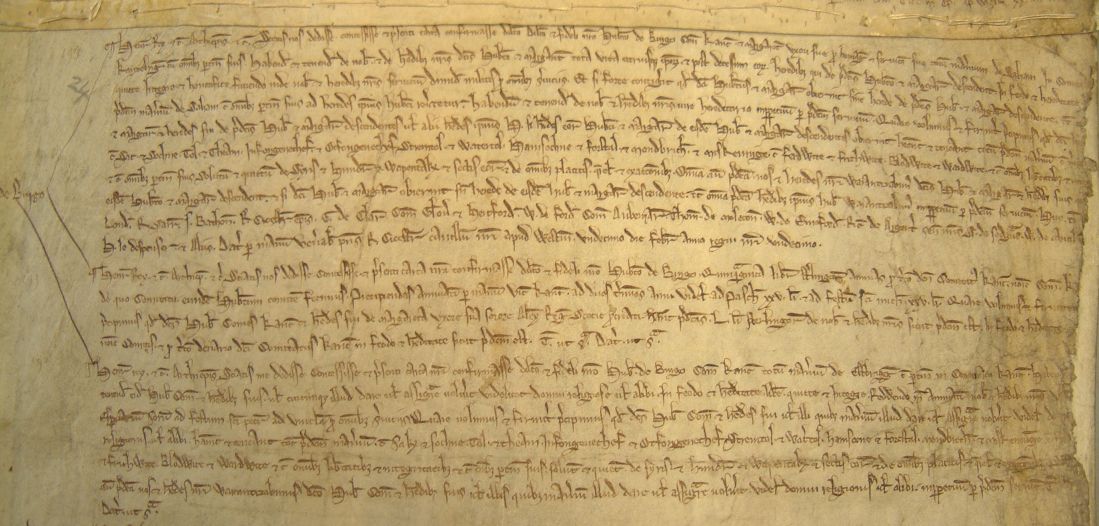
The royal acta has been collected in the Regesta Regum Anglo-Normannorum (up to 1154) and the forthcoming Acta of the Plantagenets will present a new critical edition of the acts of Henry II, Richard I and John as count of Mortain (before he became king). From 1199 the royal charters are recorded in the charter rolls. Those for John's reign were edited by Thomas Duffus Hardy and published by the Record Commission in 1837 (Rotuli chartarum in turri Londinensi asservati, 1199-1216, ed. T. D. Hardy (London, 1837)), and those for Henry III and his medieval successors have been published by the HMSO (Calendar of charter rolls preserved in the Public Record Office, 1226-1516 (6 vols, London, 1903-27)). Unfortunately, the value of the latter editions is reduced by their omission of the witness lists to the charters. These witness lists have now been edited by Marc Morris in two List and Index Society volumes (The royal charter witness lists of Henry III (1226-1272) from the charter rolls in the Public Record Office, ed. M. Morris, List & Index Society, 291-292 (Kew, 2001)).
The Patent Rolls (TNA class C 66) and the Close Rolls (TNA class C 54)
Letters patent were letters issued open or 'patent' and sealed with the king's great seal pendent. Such letters covered a wide variety of business. The most important uses of letters patent were to make appointments to royal office, issue safe conducts and letters of protection, as well as to make some grants of lands or rights. Letters patent were also used for presentations to churches in the king's gift. Finally, judicial commissions of assize or gaol delivery were entered on the dorse of the patent roll. In essence, letters patent were used for public announcements where the relevant letter might need to be shown to various people.
Letters close are so-named because the writs were folded over and sealed in such a way as to 'close' the writ. Despite this, the close rolls do not contain confidential or sensitive information. Such messages would have been conveyed orally by a royal messenger bearing letters of credence, in which the king assured the recipient that the messenger was speaking on his behalf. The letter to the Norman barons of July 1224 contains such an instruction. Rather, letters close were generally used for routine administrative matters. For example, a standard letter close might order the sheriff to deliver seisin of a manor or to pay a sum of money to a named recipient. The latter were known as writs of Liberate, so called from their main clause. This was important because when the local official came before the Exchequer to account for his time in office, he could claim an allowance against his for such disbursements. From 1227 most of the liberate writs were enrolled on a separate class of Liberate rolls.
All of the close and patent rolls for the reigns of John and Henry III have been published. The rolls for the reign of King John were edited by Thomas Duffus Hardy and published as Rotuli Litterarum Patentium in Turri Londinensi asservati, 1201-1216 (Record Commission, 1835) and Rotuli Litterarum Clausarum in Turri Londinensi asservati, 1204-1227 (2 vols, Record Commission, 1833-4). The patent rolls up to 1232 and the close rolls for the rest of Henry III's reign are also available in full Latin transcriptions in Patent Rolls of the Reign of Henry III preserved in the Public Record Office (2 vols, HMSO, 1901-3) and Close Rolls of the Reign of Henry III preserved in the Public Record Office (14 vols, HMSO, 1902-38). The patent rolls from 1232 have been calendared in English as Calendar of the Patent Rolls preserved in the Public Record Office (HMSO, 1906-).
As mentioned above, there has been relatively little historical study of the original writs issued by the thirteenth century chancery, mainly because historians have access to the chancery rolls. There is no collection or corpus of the original letters close or patent issued under John or Henry III. The first image shows a letter patent of John in favour of Robert earl of Leicester. Although this letter was actually enrolled by the chancery clerks in the charter roll, it is clearly a letter patent. The letter would have been authenticated by a seal appended to the narrow strip cut from the bottom of the parchment. The second image shows a letter patent of Henry III in favour of his half-brother William de Valence and the third shows a letter patent with appended seal.
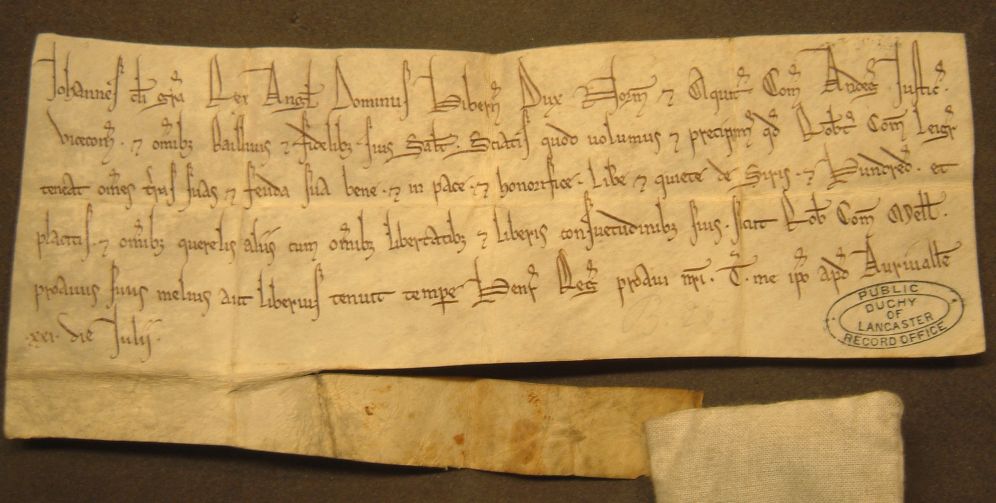

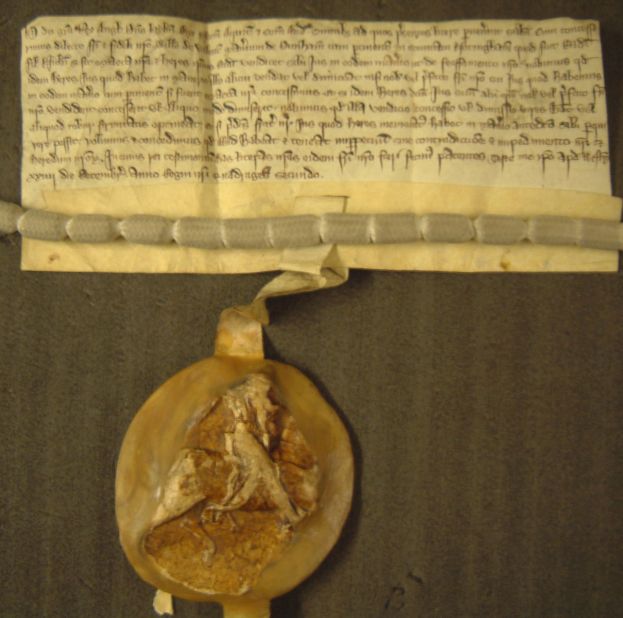
The second image shows an enrolled copy of a letter sent to some leading Norman lords in 1224 asking them to listen to Henry de Trubleville, whom the king was sending to them to discuss his business. Henry came from a Norman family that was conspicuous in managing to maintain its interests on both sides of the English Channel after 1204.

The Fine rolls (TNA class C 60)
Fines were offerings made to the king for royal favour. This could be for grants of lands and offices, or feudal rights such as wardships or marriages in the king's hands, or in cases where someone had fallen foul of the king's anger. From the mid thirteenth century there is also an increasing number of entries relating to the king's financial interests. These include writs of diem clausit extremum to escheators on the death of tenant-in-chief and writs of livery of seisin in favour of heirs. The rolls also contain orders concerning lands in the king's hands for various reasons, including those seized as terre Normannorum. There are also numerous entries concerning debts owed to the Crown, in particular writs to the Exchequer ordering the pardoning of debts or new terms for repayment. In the reigns of Henry III and Edward I in particular the rolls include many small fines (usually one-half mark) for judicial writs.
The fine rolls earlier than the reign of Henry III are printed in Rotuli de Oblatis et Finibus in Turri Londinensi asservati, tempore Johannis, ed. T. D. Hardy (Record Commission, 1835). Selected entries from the rolls of the reign of Henry III are printed in Excerpta e Rotulis Finium in Turri Londinensi Asservatis, ed. C. Roberts (2 vols, Record Commission, 1835-36). This has now been superseded for the first period of Henry III's reign by the Fine Rolls of Henry III project, an online edition providing a full English translation, indexes and a search facility. The website also has very high-quality images of the rolls themselves. There is a great deal of material relating to the terre Normannorum and to families and places featured in the Lands of the Normans dataset. Some examples are:
At intervals during the year, the chancery would extract details of fines and enter them onto the Originalia roll, which would be sent to the Exchequer. The Exchequer clerks would then note the new debts, and writs would be sent to the sheriffs for collection. The debts would also be entered into the Nova Oblata section of that year's Pipe Roll to be audited.
Exchequer
The Exchequer was not originally a department but rather an occasion, so named from the chequered cloth used during the accounting process. Every year, the clerks of the Exchequer would audit the accounts of the king's local officers. At first, the Exchequer met twice per year, at Michaelmas and Easter, but as the king's government expanded, the business of the Exchequer increased until it essentially sat all year.
The Pipe rolls (TNA class 372) and the duplicate Chancellor's rolls (TNA class 352)
The earliest surviving Pipe Roll dates from 1130 and the rolls survive in an almost continous sequence from the reign of Henry II. The Pipe Rolls record each sheriff's annual audit before the Exchequer and follow a set format. The sheriff first answered for the farm of the county, a fixed sum based on the value of the royal lands in that county and the other sources of income collected by the sheriff. Since many royal properties had been granted out by the king, the sheriff was allowed the value of any royal manors not in his hands against the county farm. This list of terrae datae is a valuable source. The roll also includes accounts for manors held at farm and boroughs, as well as crown debts owed by private individuals. Some of these debts could remain on the rolls for decades. The roll concludes with a list of Nova oblata, or new debts incurred during the current Exchequer year. The Pipe Rolls also contain foreign accounts, so named because they were outside the standard county accounts. Examples of foreign accounts include those for manors and escheats directly managed by royal officers, the king's wardrobe, and from episcopal or religous possessions in the king's hands during vacancies.
The earliest extant Pipe Roll, for the thirty-first year of Henry I's reign (covering the Exchequer year from Michaelmas 1129 to Michaelmas 1130) was edited by Joseph Hunter in 1833 (Magnum rotulum scaccarii, vel magnum rotulum pipae, anno tricesimo-primo regni Henrici primi, ut videtur, quem plurimi hactenus laudarunt pro rotulo quinti anni Stephani regi ed. J. Hunter (London, 1833)). The surviving Pipe Rolls from 1155 to 1224, as well as that for 1230, have been published by the Pipe Roll Society. The rolls up to 1189 can be freely downloaded (as pdf or text files) from the Internet Archive. The Pipe Roll for 1242 has also been published (The Great roll of the pipe for the twenty-sixth year of the reign of King Henry the Third, A. D. 1241-1242 ed. H. L. Cannon (New Haven and London, 1918)). Finally, Mabel Mills edited the Surrey account of the Pipe Roll for 1295 and her introduction is a valuable guide to the later rolls (The pipe roll for 1295, Surrey membrane (Pipe roll 140), ed. M. H. Mills, Surrey Record Society, 7 (Guildford, 1924; reprinted 1968).
The first image shows the county account for Surrey in 1199. The list of allowances against the sheriff's account for terre datae (lands granted by the king) includes Gomshall, held by William de Es, and lands in Ham in Kingston-upon-Thames, Wallington and Ewell held by the heir of Maurice de Craon. All these estates would be confiscated by 1204 as their owners remained in France, in opposition to King John, forfeiting their lands in England.

The second image shows an account for escheats in Essex in the same year, including the future terre Normannorum manors of High Roding and Bradwell-on-Sea, and Shopland.
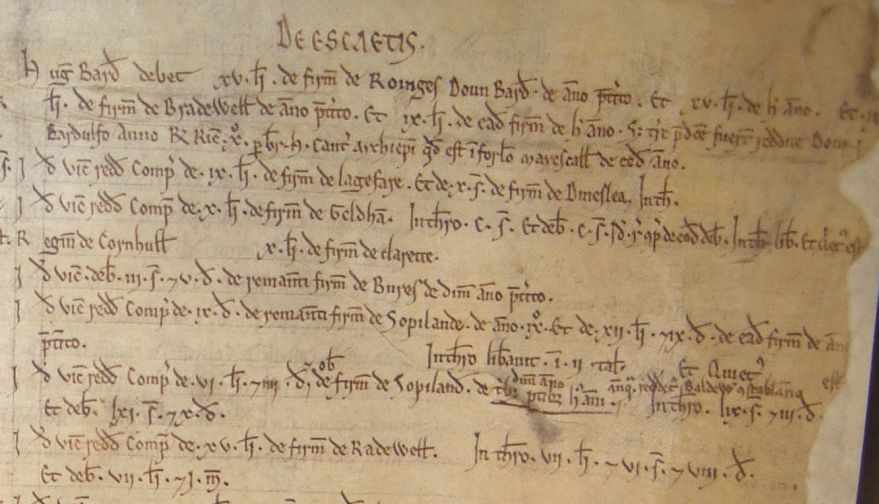
The third image shows the nova oblata, or new debts, from the county of Dorset in 1199. The last entry is a fine made by Robert de Bickleigh to recover lands held of his fee that had been confiscated from William Pippard. Bickleigh subsequently granted these properties to the sons of Robert de Harcourt, one of the most prominent Normans at John's court, and after the loss of Normandy these properties were once again confiscated and returned to Bickleigh.

The Exchequer also produced other records, which survive in increasing number from the thirteenth century onwards. These include the receipt and issue rolls, which record royal income and expenditure on a daily basis. The receipt rolls are particularly valuable, because they shed light on the rhythms of royal finance, which tend to be hidden in the annual figures presented in the Pipe Rolls. Additional information about royal finances was also recorded on the Memoranda Rolls. There was not sufficient time available to consult either of these sources in any systematic way.
Legal records
Medieval England contained a multiplicity of overlapping jurisdictions. The first division was between the secular and religious courts. In addition, there was a separate area of religious jurisdiction with the possibility of appeal to the Pope. In addition to ecclesiatsical manors, the religious courts also heard testamentary pleas about wills and sworn agreements. On the secular side, a distinction can be drawn between the common law jurisdiction exercised by the king's justices of the bench, coram rege and in eyre, and the customary courts (royal courts of the hundred and county, private seigneurial and manorial courts, and the courts of boroughs). The Lands of the Normans project has mainly focused on the former, the central courts and itinerant justices. There are very few surviving records from the other local courts for the twelfth and thirteenth centuries. The most common are records from manorial courts, but these ar mostly concerned with the business of unfree tenants rather than the landowning class. The first plea rolls from the county court date from the early fourteenth century, by which point the jurisdiction of the county courts had been restricted to minor civil pleas. During the period under study, our knowledge of these courts mostly reflected in the records of the other courts.
The central courts
The bulk of surviving records come from the central royal courts of the bench and coram rege. Although the rolls of the two courts were originally kept distinct, for the period up to 1272 they have been combined into a single class, TNA class KB 26). Both the bench and court coram rege (later known as the Common Pleas and King's Bench respectively) developed from the omnicompetent curia regis in the late twelfth century. It is sometimes difficult to draw firm distinctions between the composition and business of the two courts. The bench generally sat at Westminster, although it could be held elsewhere, rather than travelling with the king. The business of the Bench also tended to the more routine pleas, reserving more debatable or politically sensitive cases to be heard coram rege. Certain cases, such as trespass, were generally reserved for the court coram rege, which could also hear pleas involving the king or the courtiers or magnates. The court coram rege could also hear appeals about cases heard before other courts. Between 1209 and 1214 John closed the bench and heard all pleas in his own court. In reaction to this, clause 17 of the 1215 Magna Carta specified that the bench should sit at some certain place and thereafter the bench was more or less settled at Westminster.
The surviving plea rolls of the Bench and the court Coram Rege have been edited down to 1250 (Curia Regis Rolls (20 vols, London and Woodbridge, 1922-2006). The Curia Regis Rolls provide a Latin transcription of the rolls and good indexes, although the most recent volumes lack a subject index. From 1250 images of the rolls can be viewed at the website of the The Anglo-American Legal Tradition. Images of two earlier pleas touching on issues related to the 'lands of the Normans' are shown below. The first lists the several ocassions on which the manor of Great Brickhill changed hands after 1204. In the second, Simon de Lindon, who had recovered his family's manor of Easton-on-the-Hill from William du Hommet after 1204, accuses Roger de Easton of taking money to the Hommet family in France.
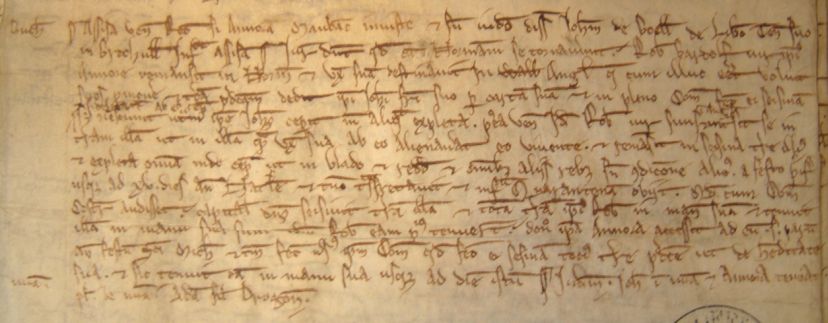
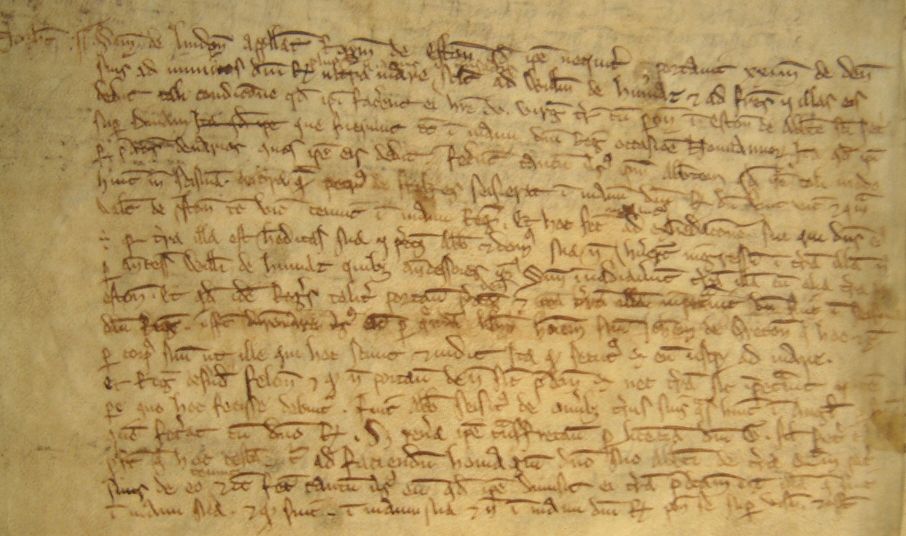
The records of the general eyre and commissions of assize and gaol delivery (TNA class JUST 1)
Itinerant justices played an important role in the medieval judicial system, literally bringing the king's justice into the localities. In the twelfth century and during the first half of the thirteenth century, the business of the central courts was still relatively limited. Local landowners were more likely to come into contact with royal justice during one of the periodic visitaions of the eyre. The general eyre was the most imposing demonstration of royal authority. Every several years, panels of justices visited each county in turn to hear all pending civil pleas and criminal actions. As the intervals between visitations grew longer, the king began to issue individual assize and gaol delivery commissions, appointing one or more justices to hear specific pleas.
The rolls of the general eyre are some of the most interesting sources available to the historian. Many rolls have been edited and published, mostly by local record societies. Most assize and gaol delivery commissions are only known from the letters appointing the justices, which were endorsed on the Patent Rolls and most records from the earliest commissions have been lost. Some rolls survive from the second half of Henry III's reign and increasingly from that of Edward I, but these are not easily accessible, since they have not been edited or indexed. The Lands of the Normans project largely concentrated on the records of the central courts, and the wealth of material in the eyre rolls has not been systematically analysed.
The image below shows an assize of mort d'ancestor from the Bedfordshire eyre of 1227. Gilbert fitzAdwin had earlier brought suit against Elias de Beauchamp concerning this same property, but Elias had died before the eyre, leaving a young daughter Beatrice as his heiress. FitzAdwin thus brought suit against John de Scalers, in whose keeping Beatrice was, and Ivo de Blackwell and Alice his wife (widow of Elias and who was holding part of the property in dispute as her dower). The plea was adjourned because both sets of defendants vouched Beatrice to warrant their right.

Final concords or Feet of Fines (TNA class CP 21/1)
These were a means of compromising legal disputes. The litigants would petition the king (usually paying a small fine) for licence to concord their dispute and to have this recorded in a fine or chirograph. This type of document was formalised in 1195 although there are some earlier fines made before the kings court. After 1195 the final concord had a tripartite structure so that both parties had a copy and the third (at the foot - hence the alternate name 'feet of fines') was retained by the court. Final concords were written by an official, the chirographer. The chirographer was employed by the bench although he and his assistants also wrote the fines made before the justices in eyre. Final concords were an attractive means of transferring property or making agreements, because an independent copy of the fine was kept by the court. The fulfillment of a final concord could also be litigated before the royal courts using the plea de finis facti. It is clear that many final concords are in fact fictitious or collusive litigation used for the purpose of recording an agreement, although others are clearly the resolution of genuine legal disputes.
The final concords for many counties have been published by local record societies, although the coverage is far from complete and the standards of editing and indexing can vary greatly. The image below shows a final concord drawn up in 1241 between Isabel de Bolebec, dowager countess of Oxford and the abbot of Woburn, concerning thirty acres of land in Chesham Higham. Isabel had originally brought her plea against Hugh de Bray and Beatrice his wife (the daughter and heiress of Elias de Beauchamp by his second marriage - Elias had previously been married to Constance de Bolebec, sister of Isabel).
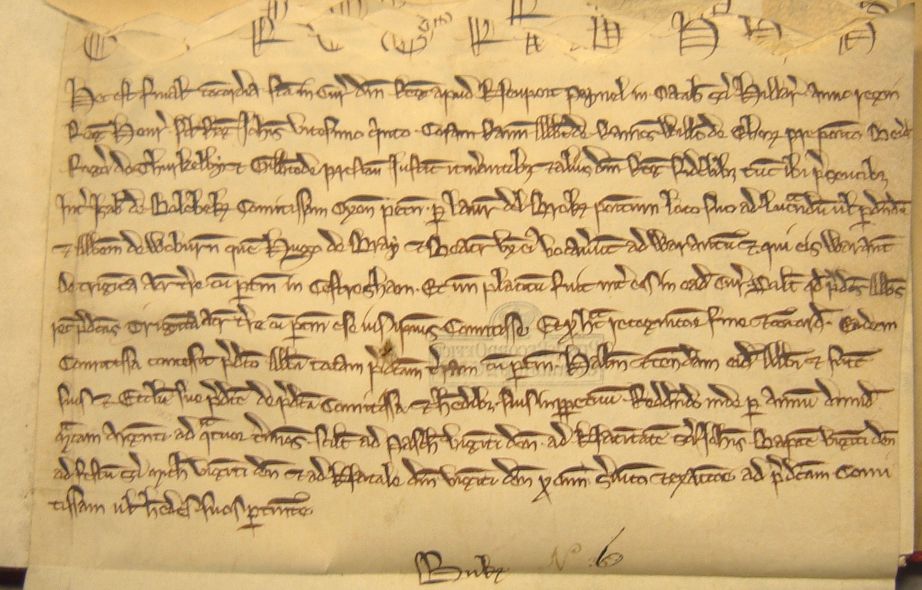
There is also a great deal of information in other classes of records about the workings of the courts in general and concerning particular pleas. An obvious example is the proffers made to have judicial writs entered on the fine rolls. Such promises of payment would also appear as debts in the Pipe Rolls, together with notes of amercements imposed on litigants for infractions such as default by the defendant or the failure of the plaintiff to proceed with their suit. The issue of commissions of assize and gaol delivery were recorded on the dorse of the patent rolls and the close rolls contain some letters about the progess of particular disputes, such as the postponement of a plea because one of the parties was busy on royal service. These external perspectives on the judicial system are especially valuable given the uneven survival of records produced by the courts directly.
French governmental records
The Lands of the Normans project has also consulted a sample of records for French royal government, particularly after the annexation of Normandy to the royal domain in 1204. Until the reign of Philip Augustus (1180-1223), royal records consisted primarily of charters and letters only. These remain an important source for the separation of England and Normandy, particularly the king's grants redistributing the lands of those who remained loyal to King John and forfeited their estates in Normandy and other parts of Northern France; the king's acts were edited in Recueil des actes de Philippe Auguste, roi de France, ed. H. Delaborde et al. (6 vols, 1916-2006). Many of them are known only from copies that survive in the registers of outgoing acts kept by King Philip's officials. However, other sources appear after 1204. The records of judicial decisions before the revived Norman exchequer court are a valuable source for the families and properties affected by the collapse of the Anglo-Norman realm, and were published by Léopold Delisle as Recueil des jugements de l'échiquier de Normandie (Paris, 1864). From 1204 onwards, the king of France also held extensive inquests into landholding and his own rights in his newly acquired provinces such as Normandy, and the records of these inquests represent one of the chief sources for the Anglo-Norman aristocracy; most were published in Recueil des Historiens de la France, ed. D. Bouquet et al (24 vols in 25, Paris, 1738-1904) [RHF], vol. 23, or Registres de Philippe Auguste, ed. J.W. Baldwin (Paris, 1992). Under King Philip's son Louis VIII (1222-6) and grandson Louis IX (Saint Louis, 1226-70), numerous further inquiries were held, notably the inquests into complaints against the kings of France and their officials known as the Querimoniæ Normannorum ('complaints of the Normans', 1247), published in RHF, vol. 24. These sources and a few other published inquests have been selectively consulted for the Lands of the Normans database, and will be crucial in the planned systematic study of landholding by Anglo-Norman families in Normandy before and after 1204.
'Private' records
As well as the records produced by the royal government, private landowners issued charters and letters and produced documents in the management of their own estates. The great lay magnates and religious houses had their own administrations similar to those of the king. Indeed, it was said that the bishop of Lincoln was the lord of a greater part of the kingdom than the king himself. Lord compiled manorial account and court rolls to maintain their interests, and issued charters to favoured religious houses or individuals. These documents must have been produced in great number, although most have been lost in the intervening centuries. Survival was more likely for monastic archives or where the collections came into the hands of the Crown, for example, when estates were confiscated or where deeds were submitted in evidence to royal courts.
The most important class of private record for the Lands of the Normans project are property deeds, most often in the form of charters. These can survive either in the original or in copies entered into cartularies or referred to in other sources (especially when recited cited during legal disputes). Charters have an obvious value for reconstructing landholding, but also shed light on patronage, and especially that of religious houses, which was often associated with particular families. Also, in the same way that the witness lists to royal charters can be used to reconstruct attendance at court, the evidence of witnesses to private charters can indicate connections within landed society.
The charter evidence is particularly important for Normandy because of the relative scarcity of governmental records, at least in comparison to England. Although the Norman exchequer rolls and the records of English government are informative about the genealogy of Norman families and their landholdings in Normandy, we must also rely heavily upon documents collected in the archives of Northern France. The Lands of the Normans database includes a number of such charters, although the limits on the time available meant that those that were included tended to be the texts that provided most evidence of family relationships and landholding. There is undoubtedly more data to be mined from this source. It should also be noted that the English charter sources, published and unpublished, have yet to be studied in the same systematic way for the project as the records of the royal government and there is undoubtedly a great deal of valuable information still to be uncovered.
Charters of Anglo-Norman landowners.
Another important class of source is contemporary narratives. Such medieval historical writing is generally classed as chronicles, although they could also take the form of biographies (mostly hagiographic in nature) or histories of religious houses. Earlier generations of historians used these chroniclers as the basis for their studies, but most recent work tends to focus on documentary sources. The main value of chronicles is to provide an insight into medieval mentalitiés or contemporary opinions about events rather than as a source of 'facts'. In the Lands of the Normans project, the dataset includes some references to chronicle evidence. For example, the History of William the Marshal describes Ralph de St-Samson as the keeper of the infant Henry III and Orderic Vitalis and Robert de Torigni provide evidence for the early history of the Sauqueville and Taisson families.
Conclusion
This brief summary of the historical sources is intended to illustrate the amount of surviving evidence and the variety of the different sources in which that evidence can be found. It should be noted that the project concentrated on a sample of around sixty Anglo-Norman landholders taken from the Rotuli de Valore Terrarum Normannorum. The database is founded on a systematic analysis of the above sources from the start of John's reign until 1244 for the people and places in our sample. Since this project lasted only one year, not all of the information collected could be entered into the database, although some of it has been used in the histories of particular families. Furthermore, other mentions of terre Normannorum or of Norman landholders outside our sample were also noted but most of these people and places were not entered into the database. hese notes form the basis for the handlist of terre Normannorum in England. Apart from the sources consulted for this project, there is a great wealth of untapped material that would contribute greatly to our understanding of the history of this period as well as the genealogy of Anglo-Norman families and the descent of the properties they held.
![Battle of Bouvines and the flight of Hugh de Boves (1214). MS 16, f 37r[41]r.
Reproduced by permission of the Master and Fellows of Corpus Christi College, Cambridge. Battle of Bouvines and the flight of Hugh de Boves (1214). MS 16, f 37r[41]r.
Reproduced by permission of the Master and Fellows of Corpus Christi College, Cambridge.](images/cc-ms16f37r-HughdeBoves-480x143.gif)




